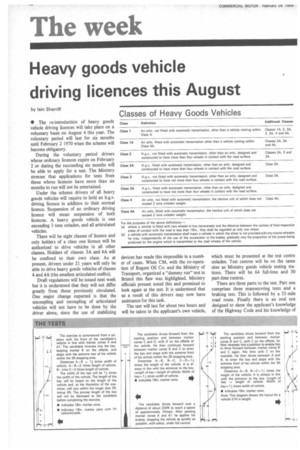Heavy goods vehicle driving licences this August
Page 16

Page 17

If you've noticed an error in this article please click here to report it so we can fix it.
by lain Sherriff • The re-introduction of heavy goods vehicle driving licences will take place on a voluntary basis on August 4 this year. The voluntary period will last for six months until February 2 1970 when the scheme will become obligatory.
During the voluntary period drivers whose ordinary licences expire on February 2 or during the succeeding six months will be able to apply for a test. The Ministry stresses that applications for tests from those whose licences have more than six months to run will not be entertained.
Under the scheme drivers of all heavy goods vehicles will require to hold an h.g.v. driving licence in addition to their normal licence. Suspension of an ordinary driving licence will mean suspension of both licences. A heavy goods vehicle is one exceeding 3 tons unladen, and all articulated vehicles.
There will be eight classes of licence and only holders of a class one licence will be authorized to drive vehicles in all other classes. Holders of classes 3A and 4A will be confined to their own class. As at present, drivers under 21 years will only be able to drive heavy goods vehicles of classes 4 and 4A (the smallest articulated outfits).
Draft regulations will be issued next week but it is understood that they will not differ greatly from those previously circulated. One major change expected is that the uncoupling and recoupling of articulated vehicles will not have to be done by the driver alone, since the use of stabilizing devices has made this impossible in a number of cases. When CM, with the co-operation of Regent Oil Co. and the Ministry of Transport, organized a "dummy run" test in Bristol this flaw was highlighted. Ministry officials present noted this and promised to look again at the test. It is understood that as a result of this drivers may now have assistance for this task.
The test will last for about two hours and will be taken in the applicant's own vehicle, which must be presented at the test centre unladen. Test centres will be on the same sites as Ministry goods vehicle testing stations. There will be 64 full-time and 30 part-I me centres.
There are three parts to the test. Part one comprises three manoeuvring tests and a braking test This is followed by a 25-mile road route. Finally there is an oral test designed to show the applicant's knowledge of the Highway Code and his knowledge of onents affecting the safe operation ice.
aplication forms will be available at ces and traffic area offices shortly voluntary period starts. Appliesbe made to traffic area offices. A .iertificate should accompany the n. The Ministry stresses that this current certificate.
m where a driver has been engaged g a heavy goods vehicle for six a aggregate in the year prior to 2 1970, test exemption can be kpplication for exemption mUst be lied by a letter from the appliiployer certifying the claim. The aoints out that such claims can be .hrough inspection of records by ement section, ;.v. licences will be valid for three le a provisional h.g.v. licence will months' duration. If a driver does a h.g.v. licence for the class of is driving he must be accompa, suitably licensed passenger and h.g.v. L plate at the front and ; vehicle. This plate is I2in. square it orange background and a red L Oin. white diameter circle. While ied the driver's basic driving 11 revert to the status of a proviv. licence.








































































































